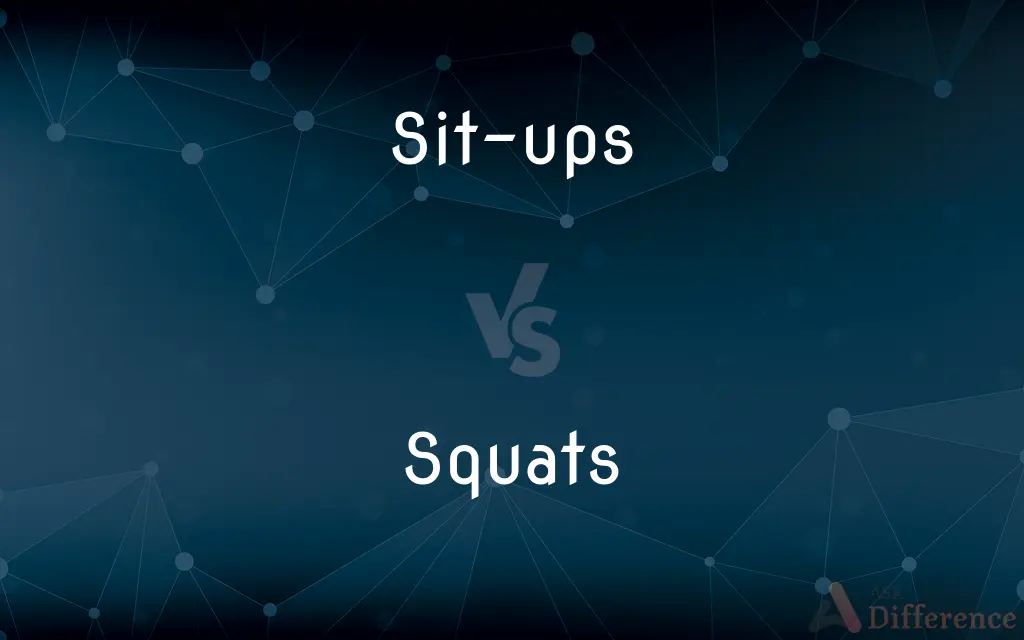Sit-ups vs. Squats — What's the Difference?
Edited by Tayyaba Rehman — By Fiza Rafique — Published on November 22, 2023
Sit-ups target the abdominal muscles by raising the torso from a lying position, while squats focus on the lower body, primarily the quads, hamstrings, and glutes. Both are foundational exercises in fitness.

Difference Between Sit-ups and Squats
Table of Contents
ADVERTISEMENT
Key Differences
Sit-ups and squats are integral exercises in many fitness regimens, but they target different muscle groups. Sit-ups are primarily a core exercise, emphasizing the rectus abdominis and oblique muscles. The movement involves lying on the back and lifting the torso towards the thighs. Conversely, squats are a lower-body exercise, targeting the quadriceps, hamstrings, glutes, and even the lower back. The movement requires bending the knees and lowering the body, mimicking the action of sitting on a chair.
Engaging in sit-ups can help strengthen the core, which plays a crucial role in stabilizing the body and supporting the spine. A strong core, developed through exercises like sit-ups, can aid in improving posture and reducing the risk of back pain. On the other hand, squats are pivotal for enhancing lower body strength, mobility, and balance. They play a role in day-to-day functions, from standing up from a chair to lifting objects.
While sit-ups mainly focus on the frontal muscles of the abdomen, variations can be introduced to target other muscle groups. For instance, twisting during a sit-up can engage the obliques more intensely. In the realm of squats, variations such as deep squats, goblet squats, or jump squats can challenge different muscles and add intensity to the exercise.
It's worth noting that while sit-ups offer numerous benefits, they can be strenuous on the lower back when performed incorrectly. Proper form and engagement of the core are essential. Similarly, squats require attention to form to ensure the knees and back are protected. Ensuring the knees don't extend beyond the toes and maintaining a straight back are vital.
In summary, while sit-ups provide a fantastic workout for the abdominal region, squats are indispensable for lower body strength and functionality. Both exercises, when executed correctly, offer numerous benefits for overall fitness and health.
ADVERTISEMENT
Comparison Chart
Primary Target Muscles
Abdominal muscles
Quadriceps, hamstrings, glutes
Body Position
Lying down, moving to a sitting position
Standing, moving to a seated position and back up
Benefit
Strengthens core, improves posture
Strengthens lower body, enhances balance & mobility
Risk if Done Incorrectly
Strain on lower back
Knee and lower back injuries
Equipment Needed
Generally none, mat for comfort
Optional: barbell, dumbbells for added resistance
Compare with Definitions
Sit-ups
A movement from a lying to sitting position without using hands.
Sit-ups became easier for her after weeks of consistent training.
Squats
A lower-body exercise involving bending the knees.
Squats are essential for building strong quads and glutes.
Sit-ups
An exercise to strengthen the abdominal muscles.
He did 50 sit-ups every morning to maintain a strong core.
Squats
A movement mimicking the action of sitting down.
She incorporated squats into her routine for better leg strength.
Sit-ups
A core workout involving raising the torso.
Sit-ups can also target the obliques with a slight twist.
Squats
A foundational exercise for lower body and core strength.
Proper form in squats can prevent potential knee injuries.
Sit-ups
A fitness staple for abdominal muscle engagement.
Many trainers recommend sit-ups for a comprehensive core workout.
Squats
A compound movement engaging multiple muscle groups.
Squats are often hailed as the king of lower body exercises.
Sit-ups
An exercise from supine to sitting without feet anchored.
Unanchored sit-ups offer an added challenge to the routine.
Squats
To sit in a crouching position with knees bent and the buttocks on or near the heels.
Sit-ups
A physical exercise in which one uses the abdominal muscles to raise the torso from a supine to a sitting position and then lies back down again without moving the legs.
Squats
To crouch down, as an animal does.
Sit-ups
Plural of sit-up
Squats
To settle on unoccupied land without legal claim.
Squats
To occupy a given piece of public land in order to acquire title to it.
Squats
To put (oneself) into a crouching posture.
Squats
To occupy as a squatter.
Squats
(Sports) To lift (an amount of weight) when doing a squat.
Squats
Short and thick; low and broad.
Squats
Crouched in a squatting position.
Squats
The act of squatting.
Squats
A squatting or crouching posture.
Squats
(Sports) A lift or a weightlifting exercise in which one squats and stands while holding a weighted barbell supported by the back of the shoulders.
Squats
Chiefly British The place occupied by a squatter.
Squats
The lair of an animal such as a hare.
Squats
(Slang) A small or worthless amount; diddly-squat.
Squats
Plural of squat
Squats
Infl of squat
Squats
An exercise starting from a standing position, lowering down, and rising up.
Deep squats challenge flexibility and strength simultaneously.
Common Curiosities
Can sit-ups help in reducing belly fat?
Sit-ups can strengthen the core muscles, but fat reduction requires a combination of exercise and proper diet.
What muscles do sit-ups primarily target?
Sit-ups primarily target the abdominal muscles.
What's the main benefit of doing squats?
Squats strengthen the lower body, particularly the quads, hamstrings, and glutes, and enhance mobility.
How many sit-ups should a beginner start with?
It varies, but beginners might start with 10-15 sit-ups and gradually increase as strength improves.
Are squats safe for the knees?
Yes, when performed correctly with proper form, squats are safe for the knees.
Can squats help in toning the buttocks?
Yes, squats are excellent for toning and strengthening the glutes.
Can squats be performed without weights?
Absolutely, bodyweight squats are effective and can be done anywhere.
Can sit-ups cause back pain?
If performed incorrectly, sit-ups can strain the lower back, so proper form is crucial.
Do sit-ups require any special equipment?
Generally, no, but a mat can provide comfort for the back.
Are crunches and sit-ups the same?
No, while both target the abs, crunches involve a smaller range of motion, lifting only the upper back off the floor.
Should feet be anchored during sit-ups?
It's not necessary, and unanchored sit-ups can offer a more challenging core workout.
Do squats benefit the core as well?
Yes, squats engage the core muscles for stability during the movement.
How deep should one squat?
Ideally, hips should descend below the knees, but flexibility and strength can dictate depth.
Can squats and sit-ups be combined in a single workout?
Yes, combining both provides a comprehensive workout for the core and lower body.
Are there variations of squats?
Yes, including goblet squats, pistol squats, and sumo squats, each targeting slightly different muscle groups.
Share Your Discovery

Previous Comparison
Social Factors vs. Cultural Factors
Next Comparison
Carnal Sin vs. Original SinAuthor Spotlight
Written by
Fiza RafiqueFiza Rafique is a skilled content writer at AskDifference.com, where she meticulously refines and enhances written pieces. Drawing from her vast editorial expertise, Fiza ensures clarity, accuracy, and precision in every article. Passionate about language, she continually seeks to elevate the quality of content for readers worldwide.
Edited by
Tayyaba RehmanTayyaba Rehman is a distinguished writer, currently serving as a primary contributor to askdifference.com. As a researcher in semantics and etymology, Tayyaba's passion for the complexity of languages and their distinctions has found a perfect home on the platform. Tayyaba delves into the intricacies of language, distinguishing between commonly confused words and phrases, thereby providing clarity for readers worldwide.













































